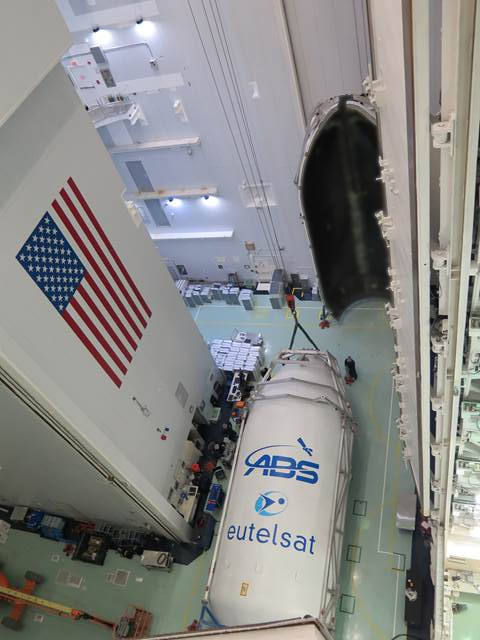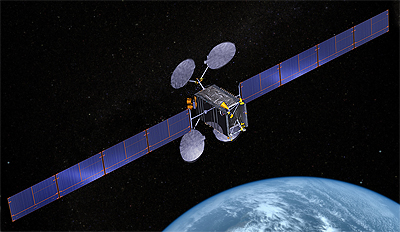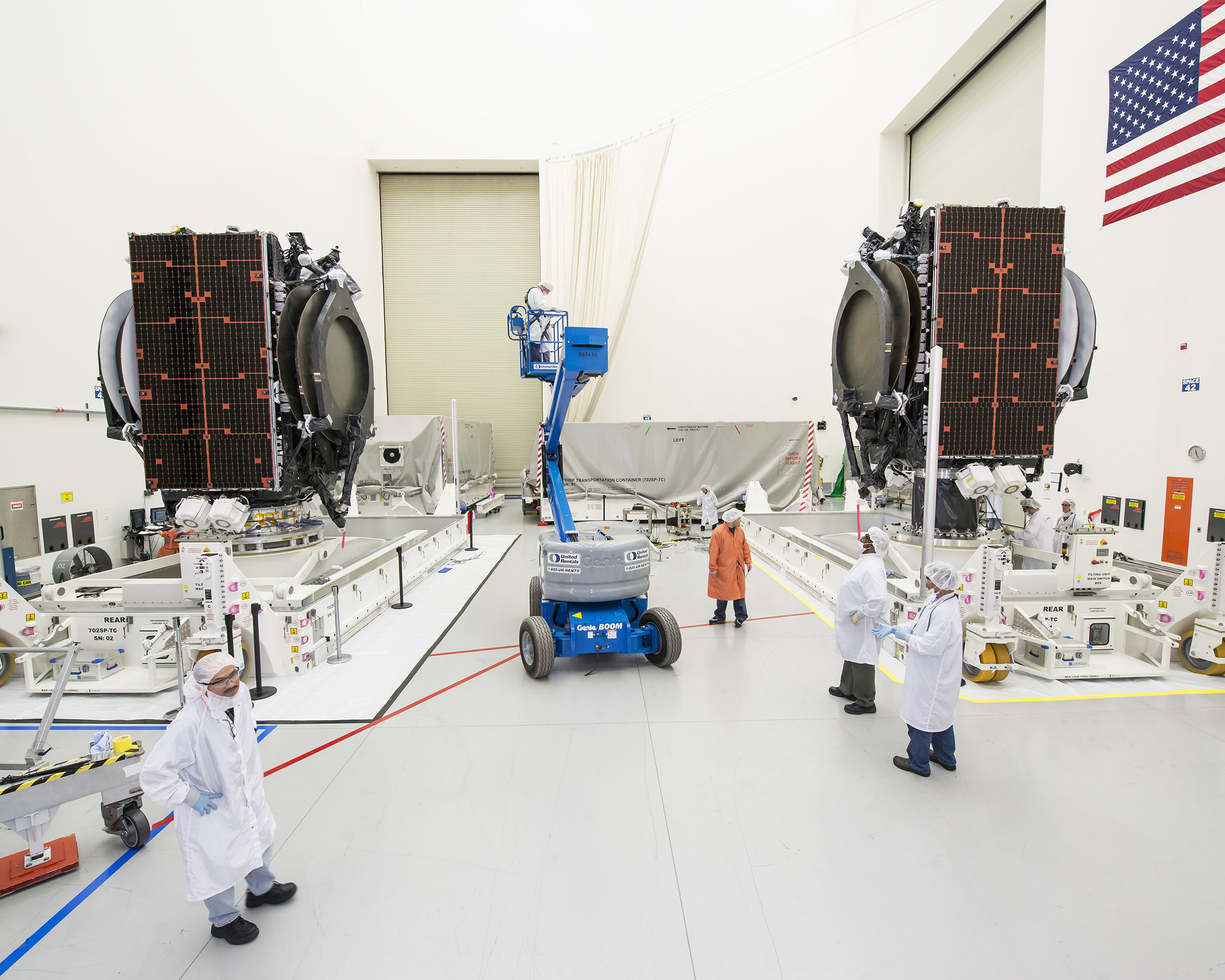What is interesting about this launch isn't about the rocket - it's the twin communication satellites sitting on top of it! Eutelsat 115 West B and ABS-3A are the first ever comsats to use
solely electric propulsion thrusters to move around, both from geostationary transfer orbit to geostationary orbit and for on-station keeping.
While that means it would take at least 6 months for the satellite to move into their planned positions, as well as having the hassle to pass through the Van Allen belts for quite some time, the result is a lighter, cheaper communication satellite that has more flexibility and no more conventional liquid propulsion system problems that crippled several satellites in the past. Each satellite weighs just 2 tonnes, yet having the same capability as a medium sized 4-5 tonne satellite!
Built by Boeing using the Boeing 702SP bus, this newest member of the Boeing BSS-702 series also have the additional advantage of being able to stack 2 of them together without the use of additional support structures during launch, which enables flexibility for ordering a share ride to orbit. This breakthrough in satellite propulsion is so attractive that other companies are starting to offer all-electric-propulsion comsats too, Airbus D&S being the other that has already having customers (the Eurostar-3000EOR bus).
Interestingly, Eutelsat 115 West B wasn't even ordered by Eutelsat! It was originally Satmex 7 for the large Mexican satellite operator when this pair was ordered together in 2012, and the connection with Eutelsat didn't came until 2014 when Satmex was acquired by Eutelsat and become their Americas division. This satellite will provide data links and TV broadcasting all over from Alaska to Cape Horn across 2 continents.
The other one, ABS-3A, is the 2nd first-hand acquired satellite in Bermuda/Hong Kong based Asia Broadcast Satellite (
their 1st in service for just over 1 year). Ordered to replace decade-old second hand satellites, it provides general communication services all over Europe, the Middle East, Africa and South America. Both companies have ordered yet another pair of similar satellites with Boeing that will also fly with SpaceX late in 2015 - ABS-2A and Eutelsat 117 West B (ex-Satmex 9).
PAYLOAD 1
Eutelsat 115 West B communication satellite
Spacecraft Overview
EUTELSAT 115 West B is scheduled to be launched by a Space X Falcon 9 rocket in first-quarter 2015.
Located at 114.9° West, EUTELSAT 115 West B will extend our satellite coverage from Alaska and Canada down to South America, with unique coverage over the Galapagos and Easter Island, transforming Eutelsat into a truly Pan-American company.
EUTELSAT 115 West B will provide the Americas with new satellite capacity to reach markets serving high-growth data, video, mobility and government applications.
Ku-band resources, connected to three fixed beams covering the Americas from Alaska to Patagonia, will provide optimised regional coverage of Canada, Mexico and South America for data services including broadband access, government connectivity and corporate networks. Video services include occasional Use, DTH and DTT.
A semi-hemispheric C-band beam will provide groundbreaking coverage from Alaska to Peru. This is optimised for services including video distribution, mobility, cellular backhaul and trunking and government services.
The EUTELSAT 115 West B satellite will be of particular interest to ISPs, aeronautical, maritime, oil & gas, telecom operators and government agencies, as well as news, sports & entertainment broadcasters.
Manufactured by Boeing Defense and Space, EUTELSAT 115 West B is the first all-electric satellite of our fleet. Its revolutionary design significantly reduces launch mass while keeping payload performance, thereby providing more efficient solutions for customers.
{colsp=2}Summary
Parameter
|
Value
Working Orbit:
|
GEO
Orbital Location:
|
114.9° West
Coverage:
|
North/Central/South America
ApA at separation:
|
43972 km
PeA at separation:
|
400 km
Inc at separation:
|
24.8°
Characteristics|
Eutelsat 115 West B
Customer:
|
Prime contractor:
|
Platform:
|
Mass at Separation:
|
Dry Mass:
|
Stabilization:
|
Dimensions:
|
Power at end-of-life:
|
Primary Payload:
|
- 34 Ku-band transponders
- 12 C-band transponders
Coverage area:
|
|
Life time:
|
|
PAYLOAD 2
ABS-3A communication satellite
Spacecraft Overview
Asia Broadcast Satellite (ABS) announced in March 2012, that it has contracted with the construction of ABS 3A to Boeing Satellite Systems. The new satellite will allow the extension of C- and Ku-band services into the Atlantic Ocean region for ABS's existing customers, and will allow them to diversify our market base for our future growth. It will replace the ABS 3 satellite.
The satellite will be constructed on the BSS-702SP bus - a version that features an all-electric propulsion system.
The satellite is part of a joint order by ABS and SATMEX of four BSS-702SP satellites. The first two satellites, ABS 3A and Satmex 7, are scheduled to be delivered together in late 2014 or early 2015. Details about the other two satellites, including names and launch plans, will be announced at a later date.
{colsp=2}Summary
Parameter
|
Value
Working Orbit:
|
GEO
Orbital Location:
|
3° West
Coverage:
|
Europe, Middle East, Africa, South America
ApA at separation:
|
43972 km
PeA at separation:
|
400 km
Inc at separation:
|
24.8°
Characteristics|
ABS-3A
Customer:
|
Prime contractor:
|
Platform:
|
Mass at Separation:
|
Dry Mass:
|
Stabilization:
|
Dimensions:
|
Power at end-of-life:
|
Primary Payload:
|
- 24 Ku-band transponders
- 24 C-band transponders
Coverage area:
|
|
Life time:
|
|



























